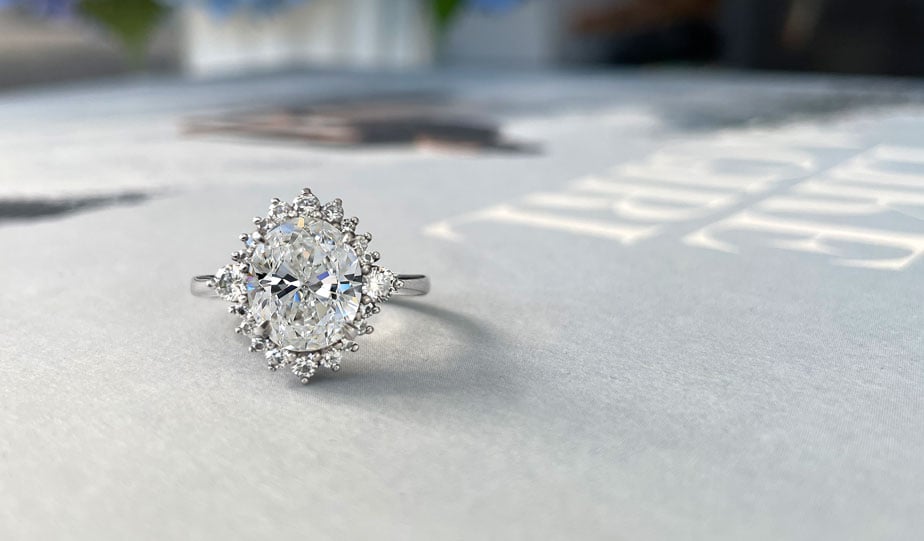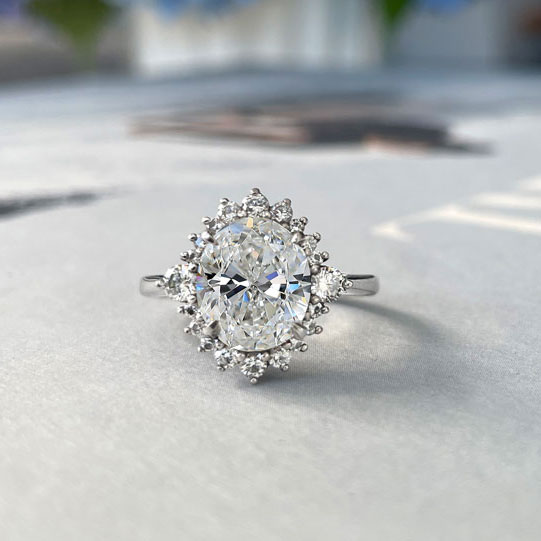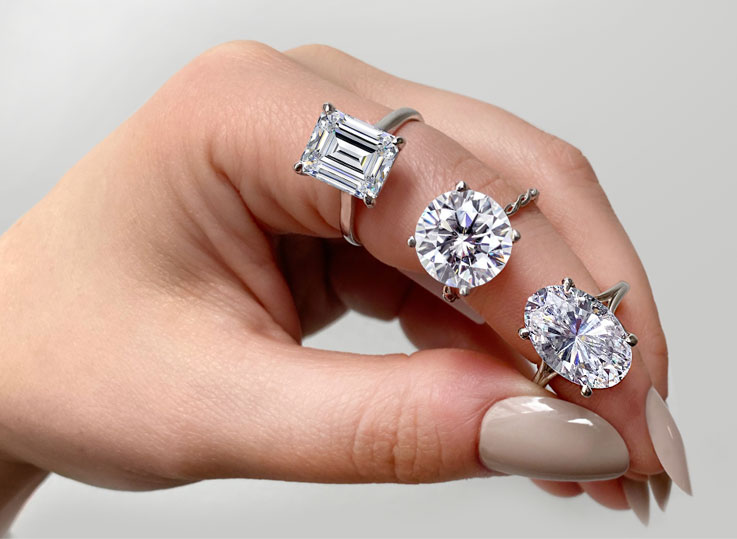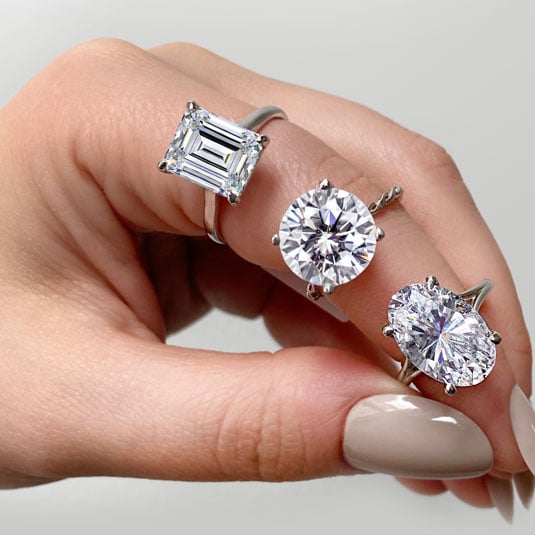


Moissanite gemstones are ethical, sustainable, and affordable, making them a common diamond alternative.
SHOP MOISSANITE RINGSMoissanite is more brilliant than a diamond. It interacts with light in a similar way as a diamond, but has an optical effect known as double-refraction which displays fiery, rainbow effects from every angle.
Moissanite production is a mine-free process, created in a lab with very little environmental impact.
Moissanite is a 9.25 on the Mohs Scale of Hardness, so it can withstand daily exposure and is highly resistant to scratching or breaking.
Moissanite is less expensive per carat than many other gemstones, like diamonds.


Discover the differences between moissanite and diamond including durability, brilliance, color, and which gemstone is for you.
BROWSE THE COLLECTION| MOISSANITE | DIAMOND | |
|---|---|---|
|
Durability
9.25 on Mohs Scale of Hardness.
Resistant to scratching and suitable for
daily wear. |
Durability
10 on Mohs Scale of Hardness. It's the hardest
mineral known to man, making it a popular
gemstone for engagement rings. |
|
|
Brilliance
Most known for its "fire," Moissanites have
an optical effect known as double-refraction.
The light that enters the stone will bounce
back at your eye after bending twice, causing
a colorful brilliance that is unmatched. |
Brilliance
A diamond has a different type of brilliance
and reflects light in three different ways,
through fire, brilliance, and scintillation.
This combination gives a diamond that
infamous sparkle. |
|
|
Color
Often labeled as colorless, depending on the
lighting, they can reflect various hues like
yellow or gray. The bigger the stone,
the more color you'll see.
|
Color
A colorless diamond is rarely found in nature
and has a body color that contains no traces
of yellow, brown or gray. Once it's cut and
polished, a diamond is given a color grade
based on the presence of color seen from
the top of the stone.
|
|
|
Price
Many factors can go into the price of
a gemstone, but moissanite is often less
expensive than a diamond per carat.
|
Price
Natural and lab-created diamonds vary on
price based on shape and the 4 C's (carat, color,
cut, clarity). In general, lab grown diamonds
are a more affordable option than natural.
|
|
|
Sourcing
As a lab-created gemstone, Moissanite is
fully traceable and has less negative
environmental impact, which makes this
gemstone a perfect substitution for
mined diamonds.
|
Sourcing
Natural diamonds are extracted by drilling
into the earth's surface to reach the layer of
the earth where diamonds have formed. In
some cases, these diamonds can be traced to
their original mine, but more often they are
untraceable.
|
Moissanite is a near-colorless gemstone that's composed of silicon carbide. First discovered in 1893 by a French scientist, Henri Moissan, in a meteor crater in Arizona. Moissan had initially thought he discovered diamonds when he first spotted the rock, but later realized that it was a rock in its own right - it was composed of silicon carbide. He later won a Nobel Prize in Chemistry, and the stone was named in his honor.
Nowadays, moissanite is extremely rare to find in nature, so the majority of what you'll find in the industry is lab-created. Compared to natural gemstones like diamonds, lab-created moissanite gemstones have a smaller carbon footprint, which results in less negative environmental impact.
Value: Price plays a huge role in any large purchase we make in our lives, and engagement rings are no different. Choosing a Moissanite as your center stone is less expensive per carat than diamonds, making moissanite a common diamond alternative.
Durability: Moissanite is a 9.25 on the Mohs Scale of Hardness, so it can withstand daily exposure and is extremely resistant to scratching, chipping, and breaking, and therefore is an ideal choice for engagement rings and everyday jewelry essentials.
Environmentally: Moissanite is a mine-free process, created in a lab with very little environmental impact, which means no soil erosion, no ecosystems damaged by damming or rerouting rivers, and no dangerous mining pits left behind.
Moissanite is a diamond simulant made of silicon carbide. A diamond simulant is a stone that has a similar appearance to a diamond but is not a real diamond.
Moissanite is not likely to increase in value, but neither is a typical diamond. Both generally resell at a substantial loss-especially if they're resold soon after being purchased. Because Moissanite is much less expensive, the total risk of loss is often lower than it is with a more expensive diamond.
Moissanite is very hard, which means that it is likely to scratch other softer gemstones and metals. It is best to store moissanite jewelry in a separate pouch or fabric-lined jewelry box.
Simply soak your ring in warm water with a mild soap and gently scrub with a soft toothbrush or cloth. Once clean, rinse off any soap residue and dry with a lint-free cloth for a freshly sparkling moissanite ring.
You can also purchase one of many formulated, non-toxic liquid jewelry cleaners. These cleaners are ideal for effectively removing the dullness that can accumulate on a gemstone surface.
Yes, you can wear your moissanite engagement ring in the shower. On its own, water will not harm your moissanite stone. However, repeated exposure to soap, shampoo and conditioner can create a build-up of oils on the surface of your ring. This can give your stone a dull appearance.
Yes! Moissanite is among the most ethical, sustainable engagement ring choices out there and making it a common diamond alternative.
Moissanite is extremely hard (9.25-9.5 on the Mohs Scale of Hardness), but it isn't indestructible. As with Diamonds, it is possible to scratch, chip, crack, or break them with a harder item or a big enough impact. Still, Moissanite is considered a 'forever' stone, which can last for generations.
Moissanite is a diamond simulant made of silicon carbide. A diamond simulant is a stone that has a similar appearance to a diamond but is not a real diamond.
This is one of the most common questions we receive! Moissanite may look like diamonds, but they are far from it.
Durability: Gemstones are measured on the Mohs Scale of mineral hardness, which assesses a gem's ability to withstand surface scratching.
Moissanite - Scores a 9.25 on the Mohs Scale, which means it's very durable for everyday wear.
Diamonds - Scores a 10 on the Mohs Scale, proving to be the most suitable for constant use, which is why it's such a popular engagement ring choice.
Brilliance: Brilliance is used to describe the light return on a stone, which is the foundation for its brightness and sparkle.
Moissanite - Moissanite reflects extremely well and is more brilliant than a diamond, plus has a higher dispersion too. It will not only give off more sparkle, but will reflect colors, as well. The bigger the moissanite, the more brilliance you'll get.
Diamond - A diamond has a different type of brilliance and reflects light in three different ways, through fire, brilliance, and scintillation. This combination gives a diamond that infamous sparkle.
Color: Color has symbolized properties of natural strength and its benefits. It is the natural color or lack of, visible within the stone.
Moissanites are labeled as colorless, but depending on the light they are in, they can reflect various hues like yellow or grey. The bigger the stone, the more color you'll see.
Whether natural or lab grown, a colorless diamond has a natural body color that contains no traces of yellow, brown, or grey. This is what gives you that sparkling, bright appearance in a diamond ring.
Price: Many factors can go into the price of a gemstone, but moissanite is often less expensive than a diamond.
Moissanites are much lower in price than diamonds and can be determined whether the stone is Premium or Super Premium.
Natural and lab-created diamonds vary on price based on shape and the 4 C's (carat, color, cut, clarity. In general, lab grown diamonds are a more affordable option than natural.
Moissanite, both natural and synthetic, are made up of carbon - like diamonds
Moissanites are made up of silicon carbide, a byproduct of carbon and silicon, whether it is manufactured or not. The reason natural moissanites are so rare is because silicon carbide is scarcely found in nature anymore.
The main differences between Morganite vs Moissanite are: Morganite has a pink, orange, salmon hue, whereas Moissanite has a nearly clear appearance. Morganite offers similar brilliance to diamonds, whereas Moissanite is even more brilliant than diamonds. Take a closer look below:
Morganite emphasizes clarity, color, depth, and brightness, while Moissanite and diamonds focus on brilliance and clarity. If you're looking for a gem store for an engagement ring, then Morganite is the choice for you, but if you want even more clarity, you may want to go with Moissanite or a diamond.
Morganite is significantly less expensive than most diamonds and has a romantic look to it due to the pink hues that everyone loves. Although it is not the same quality as a diamond, it still holds a level of elegance to it. Moissanite is another great alternative to a diamond but doesn't necessarily provide the unique coloring of morganite stones.
We offer a variety of metals and some options may vary depending on the specific type of jewelry.
Metals:
The final, and sometimes biggest factor is cost. Morganite and Moissanite are both less expensive than diamonds, and are typically the best alternatives when you're still looking for and beautify!